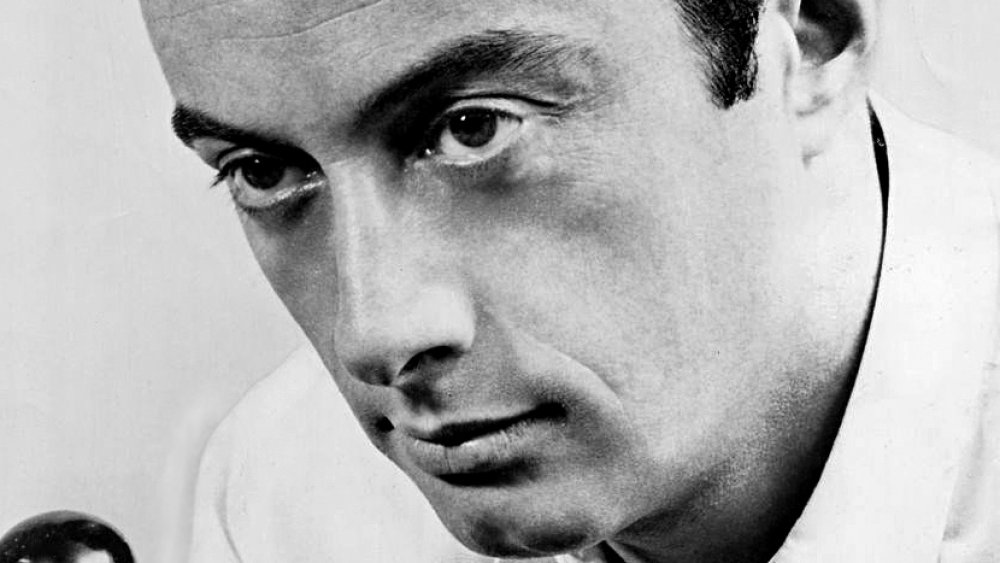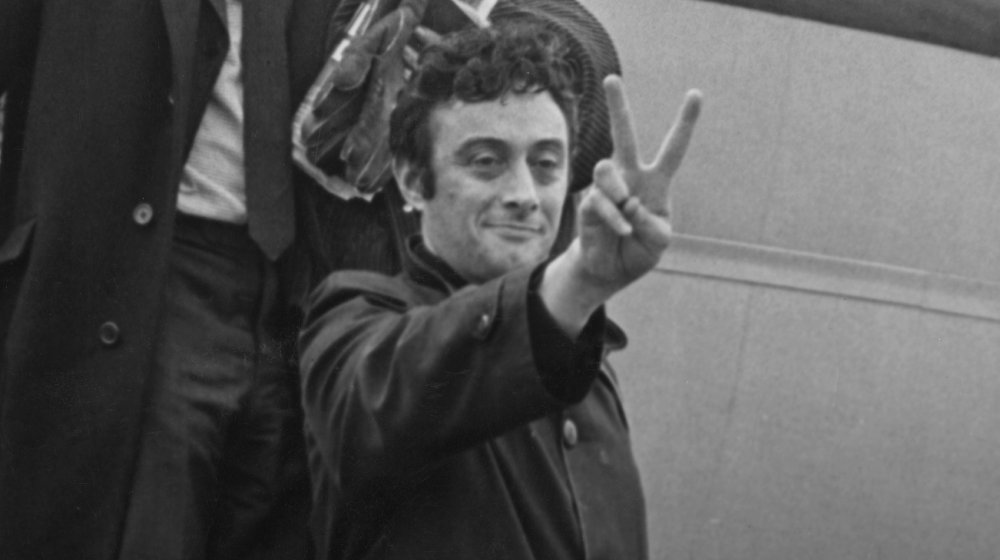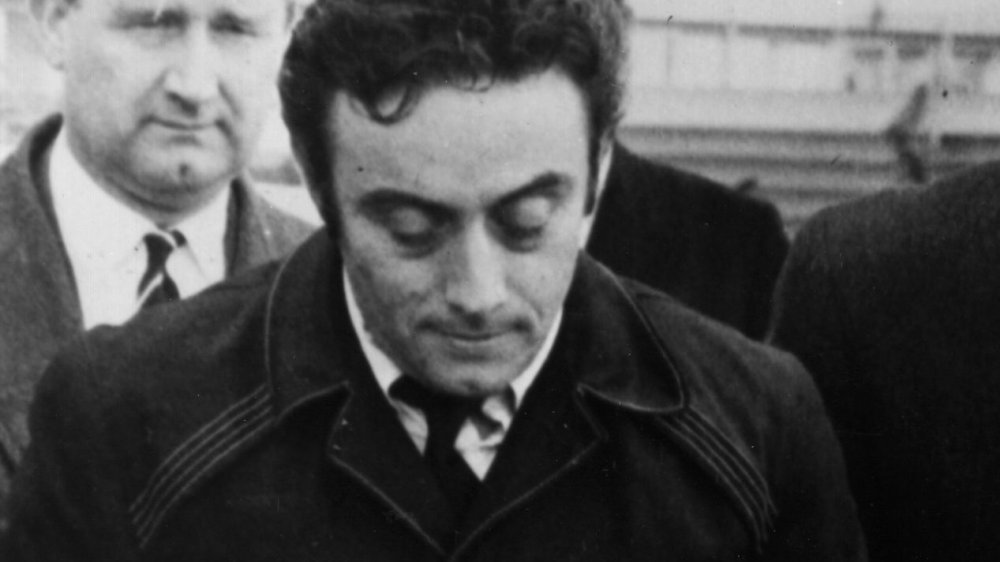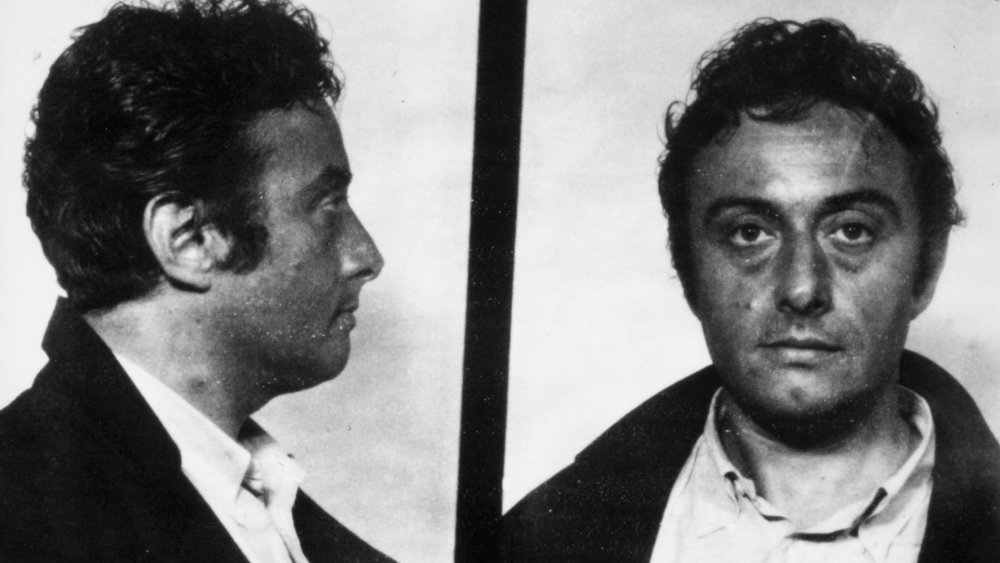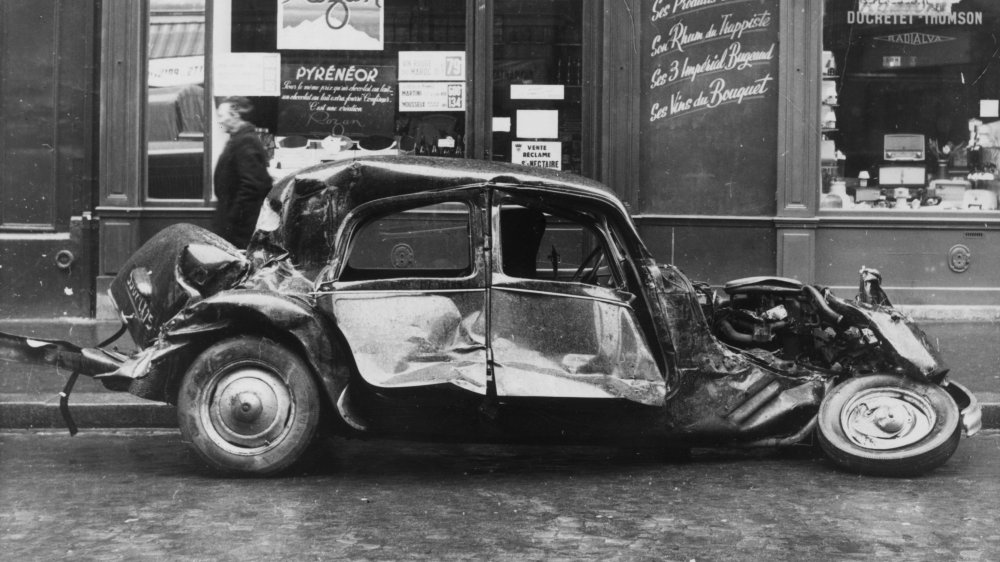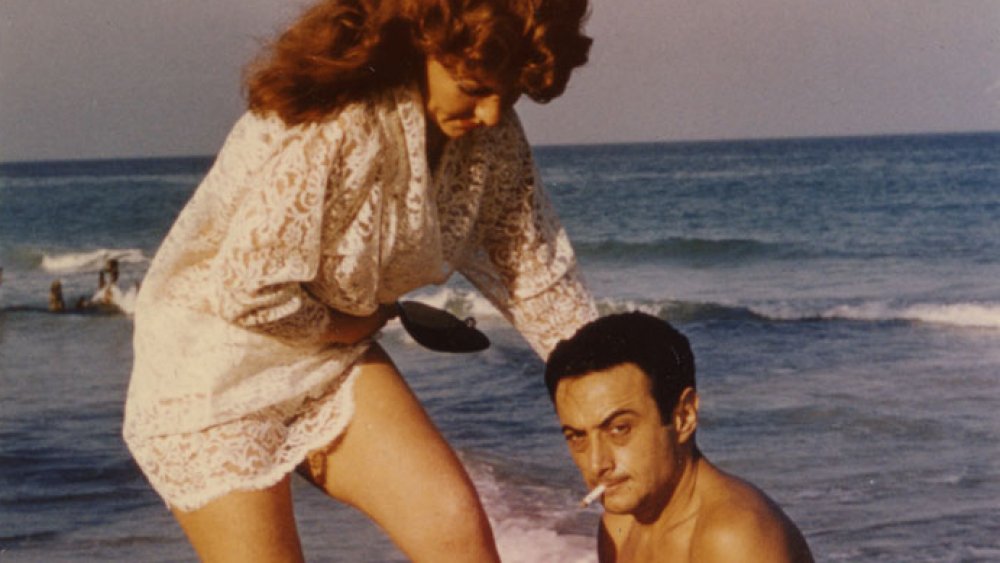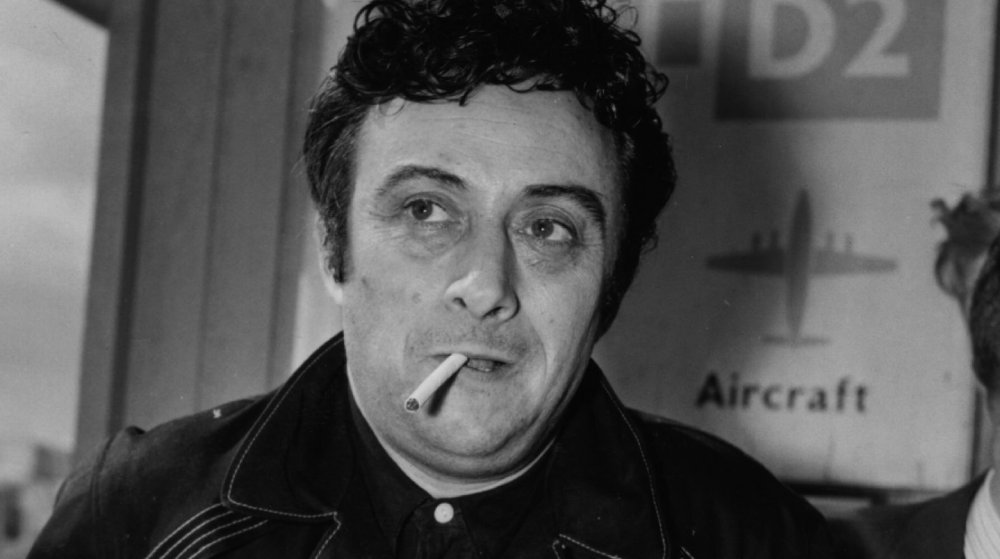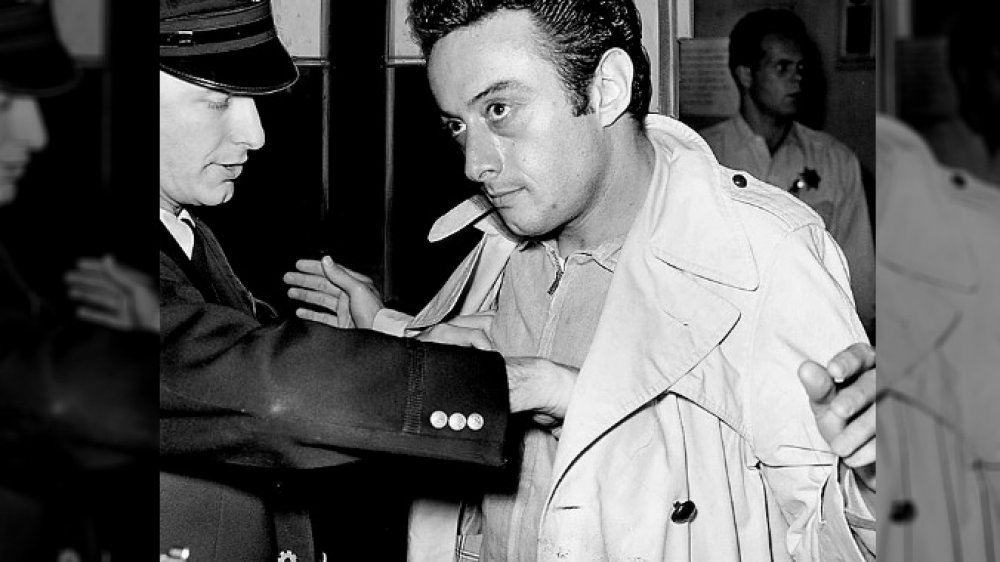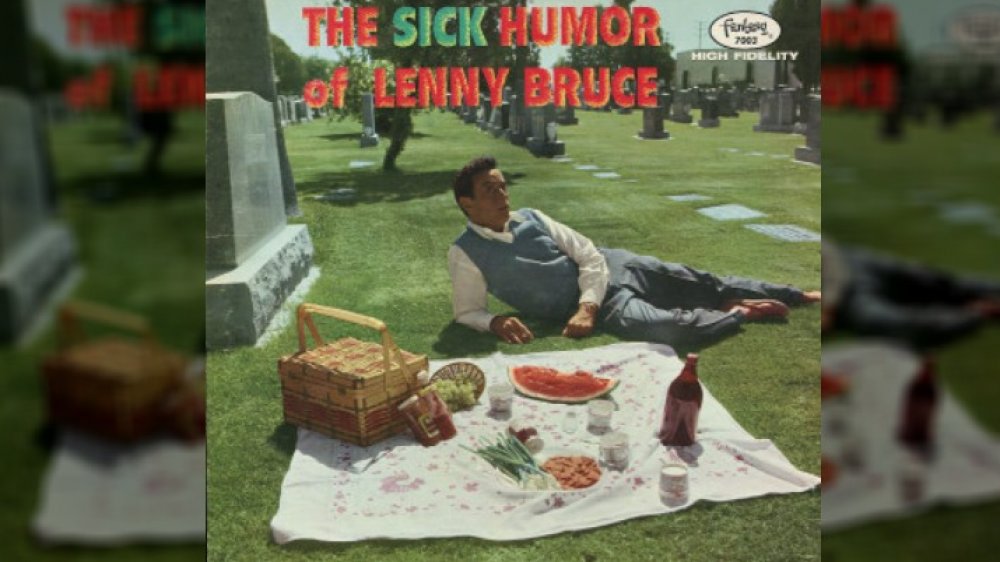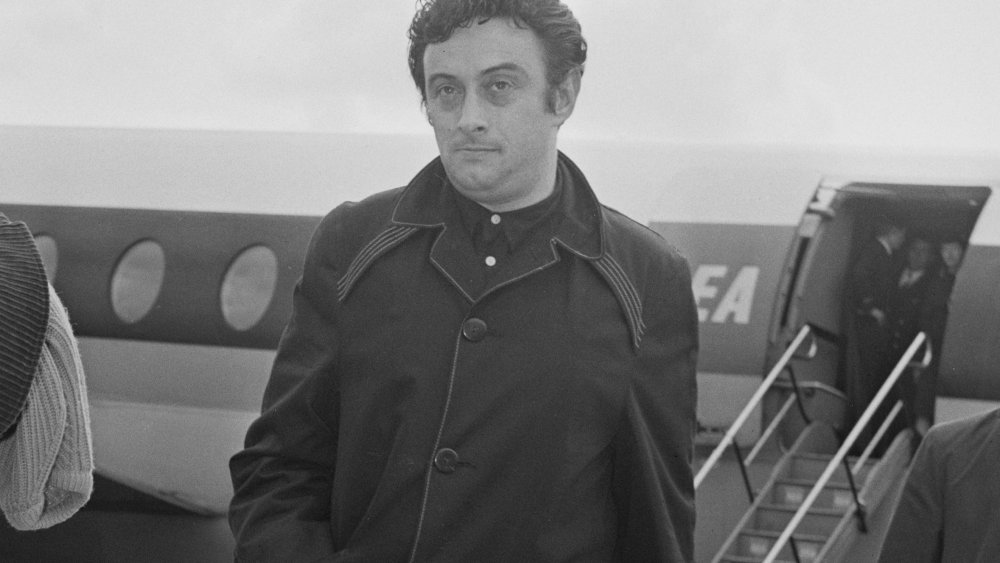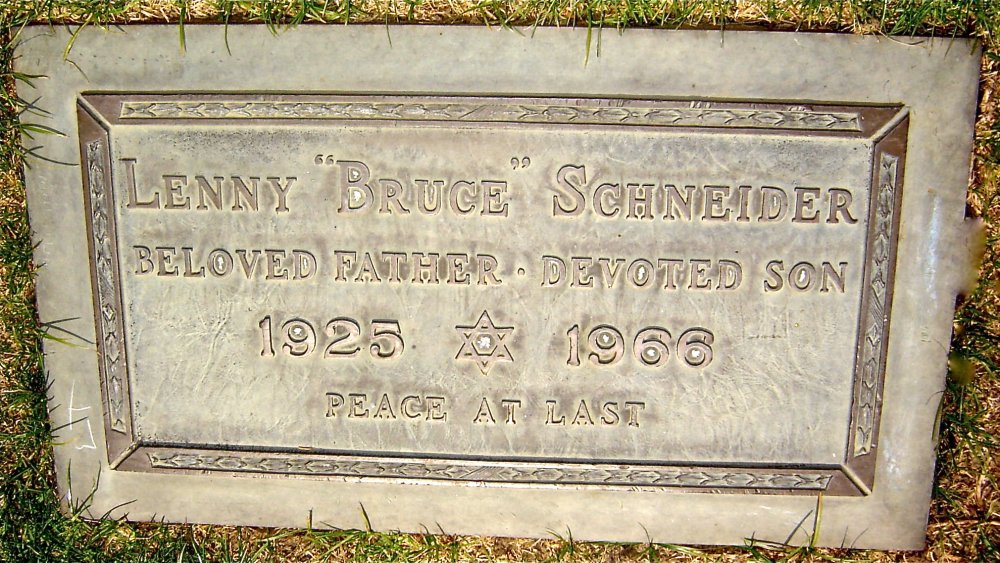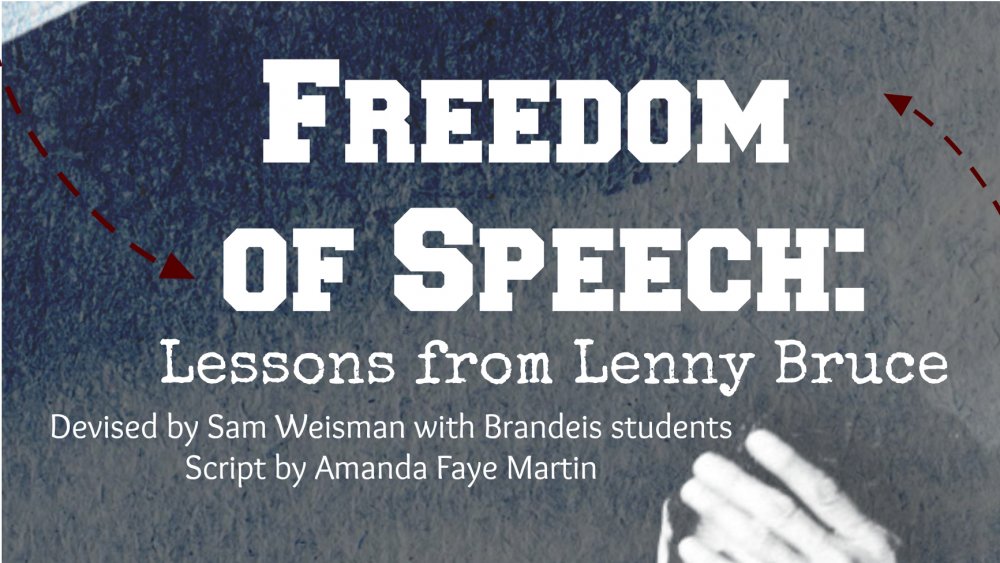The Tragic Real-Life Story Of Lenny Bruce
The comedian known as Lenny Bruce has recently come back into the spotlight since his portrayal on the hit Amazon Prime show The Marvelous Mrs. Maisel. Though Miriam Maisel may be a fictional comic, Lenny Bruce was a very real and popular, if not controversial, figure through the '50s and early '60s.
Bruce's brand of comedy could be described as a sort of social satire that promoted discourse over topics such as race, rights, drug use, sexuality, politics, religion, and any of the other topics that would make '50s suburban families lose their heads. His "sick humor," as the style was often referred to at the time, and multiple arrests for the use of coarse language turned Bruce into more than just a comedian. Through the ways in which he broke down bigotry and social taboos onstage to the discomfort of "polite society," Bruce would transform over the years into an icon within the intellectual community for the struggle over First Amendment rights. All the while, he was faced with the consequences of legal persecution.
Whereas Bruce's recent portrayal onscreen has romanticized his character, his life wasn't all spotlights and laugh tracks. The comic struggled with drug addiction, legal woes, and other tribulations that made his time on Earth hectic, to say the least.
Lenny Bruce's childhood was anything but stable
Lenny Bruce's story of struggle started long before he was a famous comedian, back before he took the name "Lenny Bruce" and was still walking around as the unknown Leonard Alfred Schneider. He was born in New York in 1925 to a podiatrist father and a mother who worked as an entertainer. His parents divorced when he was only five years old. According to Britannica, Lenny was raised by his mother and a number of other relatives afterward, presumably because her work as a dancer and an emcee would require her to be gone at odd hours and spend time on the road, a life Bruce would adopt years later.
His hectic home life made it hard for him to focus on his schoolwork, so Bruce dropped out of Wellington C. Mepham High School at the age of 16 and ran away from home, according to the biography Ladies and Gentlemen: Lenny Bruce. He found himself working on a farm in Long Island where he dug up potatoes and drove a truck for the next two years. Following his stint on the Dengler Family Chicken Farm, Bruce would do what so many other young adults did in the early '40s: join the US military to fight in World War II. As you can imagine, this wouldn't bring him the peace he was looking for when he ran away from home.
Bruce was dishonorably discharged from the Navy
With World War II roaring, Lenny Bruce joined the Navy in 1942, and the future comic and First Amendment activist would see active duty aboard the USS Brooklyn in several areas of southern Europe and northern Africa, as detailed by Ladies and Gentlemen: Lenny Bruce. A few years of Navy life would prove to be more difficult than Bruce was ready for, especially after the trauma of witnessing the bodies of nearly 40 airmen floating by his cruiser.
As a natural-born comic, one of the ways Bruce passed the time was by performing for shipmates, which would ultimately lead to his discharge from the Armed Forces. According to Bruce in his autobiography, How to Talk Dirty and Influence People: An Autobiography, he enacted a semi-elaborate ruse to get himself discharged: He'd perform an act for the crew in drag. One night, he was caught by a commanding officer, who wasn't fond of his choice of clothing, and from there, he'd go on to convince the medical staff that he was having homosexual urges, which led to a dishonorable discharge. The discharge would later be appealed to "under honorable conditions," according to The Smoking Gun. But, Bruce's act would eventually become famous enough on its own to inspire the character Klinger in the TV show M*A*S*H*.
Lenny Bruce was arrested for his 'leper' charity
Most comics begin their careers broke — it comes with the territory. Lenny Bruce was no exception to the rule during his early comedic years. In the early '50s, around the time he'd just began to successfully support himself with his jokes, Bruce and his wife, Honey Bruce, were arrested on charges of "panhandling." Why? According to Famous Trials, the couple had stolen priest uniforms and started a funding charity for a leper colony in British Guiana. They put such effort into making the scheme seem official that they received a state charter for "the Brother Mathias Foundation." A charity for this type of cause probably seemed benevolent until someone figured out that only a third of the funds raised ever actually made it where they were supposed to go.
It only took three days for the couple to raise around $8,000, which was a hefty chunk of change in 1951. Too bad only $2,500 made it to the colony. The rest went into Bruce's pocket for "operating expenses," a fact to which he would later confess. According to Middle Tennessee State University, Lenny and Honey Bruce weren't convicted of the crime, but this arrest would be the first in a long history of criminal charges for the comic.
A near-fatal car crash
Lenny Bruce had a lot of bad nights, but October 8, 1951, was particularly disastrous for the comic. Four days after opening his first major booking, worth $600, at the Monte Carlo in Pittsburgh, Bruce had his black convertible towed for illegal parking. The fine was only $8, though, and he was back on the road that evening, which he would later discover was the wrong place for him to be.
On his way back to downtown Pittsburgh for the next show of the night, Bruce pulled into an intersection assuming he had plenty of time to get out of the way before an oncoming truck could reach his car. He avoided the truck, but he didn't see the car passing the truck on its other side and crashed right into it. Both Bruce and Honey, who'd been riding on the passenger side, were ejected from the vehicle, and Honey was then run over by the truck. This was a time before seat belts. According to Pittsburgh Magazine, Bruce recalled seeing the horror of the accident step-by-step, like a slow-motion video reel from a horror film.
Bruce tried to perform later that night, but his fractured skull sent him back to the hospital instead. Honey would be worse off, spending seven weeks at St. Francis Hospital due to her substantial injuries.
Lenny Bruce's tumultuous marriage barely lasted six years
Lenny Bruce's love story starts out like any other: Man falls in love with a stripper and marries her. After marrying Bruce in 1951, Honey Harlow would stick with her husband as his career began to rise, through a car accident that nearly killed her and through a few of Bruce's most famous legal battles. Honey would join Bruce onstage and sing during performances, all while the two were hooked on heroin, which, according to the LA Times, was a prominent aspect of their marriage.
The couple would have a daughter, Kitty Bruce, in 1955, but their marriage would end shortly after. Before their divorce in 1957, things would take a crazy turn during a family trip to Hawaii, during which Honey would be arrested for possession of marijuana. During Honey's three-year parole sentence, Bruce took off unannounced back to LA with their daughter in an attempt to get full custody of Kitty. Honey broke parole to follow them and ended up serving two years in prison, according to the Encyclopedia of Arkansas.
A New York Times article pulls excerpts from Honey's book which suggest that she suspected her husband may have planted joints in her tote bag and informed the authorities of the exact time she'd be leaving the hotel. Honey says, "If Lenny did set me up. He did it out of fear. And out of love."
Lenny Bruce got a lot of police attention for some questionable reasons
It was Lenny Bruce's slew of obscenity arrests, and the rulings that pertained to them, that would lead the comic to be viewed as an icon in the fight for First Amendment rights. His first arrest on these charges came following a performance at the Jazz Workshop in October 1961, when the city of San Francisco decided that Bruce's other-the-top language and the story of his father hanging a sign from his manly no-no bits were offensive and against the law. Bruce's defense, per Famous Trials, argued that his comedy wasn't just inoffensive within the liberal jazz community in which he was performing but also socially important, and the jury sided with the comedian.
Bruce was acquitted of the charges, but that didn't stop authorities from hassling him. In fact, it brought his style of comedy and his name to the forefront of their attention. According to Biography, police began to monitor his shows, with detectives hanging out in the crowd looking for a chance to arrest him. He was charged again in California, two weeks later in Chicago, and then yet again in LA. Bruce was sentenced to a year of jail time in his Chicago hearing, but the conviction was overturned during appeal.
Bruce was sentenced to jail time in NY
The most famous of Lenny Bruce's obscenity trials took place in New York in 1964. According to Famous Trials, this case came at a time when the comic had fallen out of his prime and critics were increasingly claiming that, instead of the satire that led to Bruce's fame, he was resorting more to shock humor to draw an audience.
Regardless, the comedian's acts and the way he continually pushed boundaries had caught the attention of the Manhattan district attorney, who, alongside the Archbishop of New York, had begun investigating Bruce. The DA sent undercover police, including a former CIA agent, to attend Bruce's show at Cafe Au Go Go in Greenwich Village, where he had been performing for $3,500 per week. As you might expect, the comic was arrested after the show, yet the following night, while out on bail, Bruce performed another defiant show at Cafe Au Go Go.
This time around, according to the Free Speech Center at Middle Tennessee State University, the trail brought in tons of media attention, along with artists who testified on Bruce's behalf. Big names like Woody Allen and Norman Mailer came to his defense, poet Allen Ginsburg formed a committee against the harassment, and over 80 artists signed a petition in protest. But, in the end, Lenny Bruce was convicted and sentenced to four months, marking the final downward spiral of the comedian's life.
Lenny Bruce was labeled a 'sick comic'
The same style of comedy that brought Lenny Bruce into the courtroom and paid his bills over the years had put his persona in the center of the media's critical lens. Bruce was labeled a "sick comic" by Time magazine in 1959, according to Britannica, and several other media outlets followed suit. His comedy albums were often reviewed as "for adults only" or as extremely controversial, and he was essentially blacklisted from television. When he did make an appearance, it was often scripted and needed approval before being aired. When he showed up for a taping of the Steve Allen Show, they filmed a four-minute disclaimer which would have suggested that viewers turn off their televisions if they didn't want to be shocked, as reported by Vulture. Even with the disclaimer, the whole segment was cut by the show's sponsor and was never aired.
Bruce's reputation for sick humor, humor that broke the conventional mode of joke-telling and dealt with topics often seen as taboo, was what brought him to fame, but it also kept him from being able to perform at venues. After his New York trial, the comic was banned from several clubs, and the bookings slowed to a point that it drastically affected his finances. According to ThoughtCo., Lenny Bruce had only made $6,000 during the year of the NY trial, compared to $100,000 four years earlier.
Bruce was banned from several cities and countries
Lenny Bruce was thought of as a rebel by certain circles, while others considered him to be provocative, if not outright offensive. Due his multiple arrests, Bruce had only appeared on television six times by the time of his death. It makes sense for certain comics to be banned from certain clubs — the success of comedy is based on its viewership — but this comedian was banned from multiple cities around the country and, by the end of his life, almost every nightclub, according to Bustle.
As told by Biography, 1965 was the high point of Bruce's negative publicity. He was banned from both England and Scotland, and he filed for bankruptcy. It's often reported that Bruce was banned from Australia as well, but, according to The Dictionary of Sydney, that's not quite what happened. Apparently, the comedian was booked for two weeks' worth of performances in Sydney but walked offstage after an argument with actress Barbara Wyndon, who had heckled him from the crowd during his second performance. Sydney newspapers then attacked the comic and the rest of his shows were canceled, but he wasn't technically kicked out.
Drug problem and death
Lenny Bruce's later comedy routines lost a lot of their edge and, according to Famous Trials, morphed into onstage obsessing over his various arrests, of which there were many. In June 1963, Bruce was ordered by a California court to receive treatment at a rehab facility for addiction to amphetamine, which he was prescribed as a treatment for the lethargy he'd periodically experience as a symptom of his hepatitis. However, it's pretty well-known that heroin was his primary addiction, according to Encyclopedia.com, Bruce spent most of 1965 secluded at home.
Bruce's drug problem, most likely amped up by his recent legal and financial troubles, would kill him in August 1966, while he was awaiting his appeal for his New York conviction. The comedian was found dead on his bathroom floor from an accidental morphine overdose.
One of the prosecutors from the New York trial, Assistant DA Cuccia, commented on his sense of guilt after Lenny Bruce's death, saying, "We drove him into poverty and bankruptcy and then murdered him. I watched him gradually fall apart. It's the only thing I did in Hogan's office that I'm really ashamed of. We all knew what we were doing. We used the law to kill him."
Lenny Bruce wouldn't be pardoned until after his death
Most of the recognition for Lenny Bruce's contributions toward First Amendment rights wouldn't be recognized outside of fringe intellectual groups until after his death, when he would reach iconic status within comedy circles and mainstream society as an activist for freedom of speech. According to Famous Trials, it would take nearly 40 years after his death for his final conviction to be overturned with a pardon in 2003. When New York governor George Pataki exonerated the comedian in the state's first-ever posthumous pardon, he did so as a statement which he called "a declaration of New York's commitment to upholding the First Amendment."
Between his death and pardon, Bruce's story would inspire several characters in films such as Lenny (featuring Dustin Hoffman), television portrayals, and several biographies, not to mention all the times his name has been spoken in the courtroom in defense of someone's right to express themselves or by comedians who may have overstepped their social limits. Though his life was filled with tragedy and struggle, Lenny Bruce has secured himself as both a master comedian and champion of the First Amendment.
